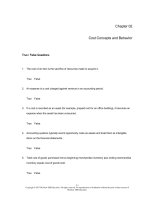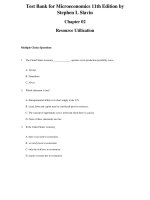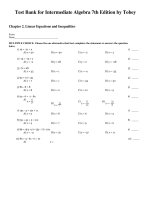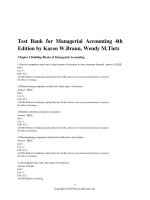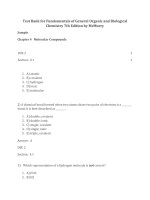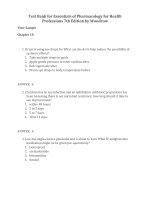Link full download test bank fundamentals of cost accounting 5th editor
Bạn đang xem bản rút gọn của tài liệu. Xem và tải ngay bản đầy đủ của tài liệu tại đây (1.43 MB, 30 trang )
Test bank Fundamentals of cost
accounting 5th editor by Lanen
Link full download:
/>
Chapter 1 Cost Accounting: Information for
Decision Making
Solutions to Review Questions
1-1.
Among the goals of an organization, a central one is to create and increase value. Cost
accounting systems are designed to provide information to decision makers in the
organization with the information they need to accomplish this goal. Therefore, the
designers of the cost accounting system need to understand how value is created in the
organization in order to design systems for their particular organization.
1-2.
Financial accounting is designed to provide information about the firm to external users.
External users include investors, creditors, government authorities, regulators, customers,
competitors, suppliers, labor unions, and so on. Cost accounting systems are designed to
provide information to internal users (managers).
This difference is important, because it affects the design of the systems. Financial
accounting systems are based on standards or rules. This allows the user to compare the
results of different firms. Managerial accounting systems do not require rules. Each firm is
free to develop managerial accounting systems that best serve the needs of the decision
makers (managers).
1-3.
B
Providing cost information for financial reporting
©The McGraw-Hill Companies, Inc., 2017
Solutions Manual, Chapter 1
1
A
Identifying the best store in a chain C Determining
which plant to use for production
1-4.
The value chain is the set of activities that transforms raw resources into the goods and
services end users purchase and consume. The supply chain includes the set of firms and
individuals that sells goods and services to the firm. The distribution chain is the set of
firms and individuals that buys and distributes goods and services from the firm.
1-5.
The customers of cost accounting are managers, from plant managers to the CEO.
1-6.
Value-added activities are activities that customers perceive as adding utility to the goods
or services they purchase. Nonvalue-added activities do not add value to the goods or
services. By classifying costs this way, the cost accounting system can help the manager
identify areas (processes) that can be improved, lowering costs and adding value to the
organization.
1-7.
Answers will vary, but should include some of the following:
Title
Major Responsibilities and Major Duties
Chief financial officer (CFO) ........ • Manages entire finance and accounting function
Treasurer ..................................... • Manages liquid assets
• Conducts business with banks and other financial
institutions
• Oversees public issues of stock and debt
Controller ..................................... • Plans and designs information and incentive systems
Internal auditor ............................ • Ensures compliance with laws, regulations, and
company policies and procedures
• Provides consulting and auditing services within the
firm
Cost accountant .......................... • Records, measures, estimates, and analyzes costs
©The McGraw-Hill Companies, Inc., 2017
2
Fundamentals of Cost Accounting
• Works with financial and operational manager to
provide relevant information for decisions
1-8.
No. Sarbanes-Oxley is a law and violations of it are legal issues. Codes of ethics are
necessary to help accountants and managers identify situations that might develop into
ethical conflicts, understand what they could do in these situations, and to learn what to do
when they believe that an ethical violation has occurred.
©The McGraw-Hill Companies, Inc., 2017
Solutions Manual, Chapter 1
3
Solutions to Critical Analysis and Discussion Questions
1-9.
We would not agree. The role of accountants is to help manage the organization. Part of
that role is to report results. Another part is to design systems that assist other managers
in making decisions to improve performance. This role requires that accountants
understand how value is created in their organizations.
1-10.
The calculation of cost depends on the decision being made. Therefore, the first question
to ask is, “What decision (or decisions) are you trying to make?”
1-11.
Costs that you could ask to be reimbursed might include the fuel, a share of the
maintenance costs, “wear and tear,” or depreciation, and insurance. To avoid
disagreements, it would be necessary to negotiate an agreement (even if only informally)
between you and your friend considering all factors. For example, you might agree that
she should pay for the gas and any other supplies (e.g., oil) needed on the trip.
If you are going along, you might change the agreement so that you split these costs.
Alternatively, you might say that because you are going anyway, she can ride along for
nothing.
1-12.
Although it is not the “job” of accounting to determine strategy, accounting provides
important information to those who do determine strategy. If the cost accounting system
provides inaccurate information, the firm may end up with an unintended strategy,
because managers are making decisions based on faulty information.
1-13.
Executive performance evaluation systems are designed for a specific company’s needs.
The systems should be flexible to adapt to the circumstances that exist in that company. A
common set of accounting principles would tend to reduce flexibility and usefulness of
these systems. As long as all parties know the accounting basis used by the system, the
exact rules can be designed in whatever manner the parties deem appropriate.
1-14.
Although not-for-profit organizations are not seeking to make a profit, they must remain
financially viable to accomplish their missions. Cost accounting information can help
managers of not-for-profit organizations by highlighting the costs of various activities,
identifying sources of revenue, and measuring performance of managers. In terms of
©The McGraw-Hill Companies, Inc., 2017
4
Fundamentals of Cost Accounting
organizational survival, cost accounting information can be just as (or more) important for
a not-for-profit as for a for-profit firm.
1-15.
Airlines are characterized by the need to own a substantial amount of capacity costs.
Managers at airlines require very sophisticated load management information that predicts
the number of passengers flying on a particular route on a particular day. If they set a
single price that would cover their costs given a certain number of passengers, they risk
flying with empty seats. Once the plane takes off, they cannot sell the seat. Therefore,
they need a flexible pricing system. Such a system requires detailed cost information
about passengers and aircraft.
The costs are unlikely to be much different among passengers. The variable costs are
relatively low (per passenger) and may include food and beverage, some baggage
handling cost, some ticket processing costs, and, depending on the plane, a (very) small
amount of fuel.
1-16.
The cost accounting issues for Nabisco are the same as for Carmen’s Cookies in the
sense that managers at Nabisco want the same kind of information as Carmen: what are
the costs of cookies, who is performing the best, and so on.
The cost accounting issues are different in the size and complexity of the operations at
Nabisco compared to Carmen’s Cookies.
1-17.
In decision-making, managers or supervisors may wish to take actions that they believe
will increase the firm’s value that are difficult to justify given available information. Often,
these situations arise when managers are using their intuition and their experience to
identify new business opportunities and cannot point to data that support their views. For
example, a marketing manager might view investment in a new advertising campaign as
necessary for remaining competitive even though it appears to increase costs. Because
the accountant does not have expertise in this area, she cannot verify the information the
marketing manager is using.
In a few cases, however, a marketing manager may wish to pursue a project because of
personal reasons (for example, because he was the champion of the product), and hopes
to have an economic analysis to justify additional advertising support. In these situations,
care must be taken to ascertain the economic merits of the plan, and, if the plan cannot be
justified on economic grounds, the manager must make the case for the project on
another basis.
The final responsibility for the decision rests with the manager. Therefore, plans that
cannot be justified on a cost analysis basis may still be adopted at the discretion of
operating management. The controller should be clear that the project is justified on a
basis other than (easily measured) costs.
©The McGraw-Hill Companies, Inc., 2017
Solutions Manual, Chapter 1
5
In the control area, the accountant is charged with the responsibility of making certain that
plans are executed in an optimal and efficient manner. In some cases this may be viewed
as placing restrictions on management actions. Under these circumstances the marketing
manager may view the accounting function as placing too great a constraint on him while
the accountant may view the marketing manager as attempting to circumvent the rules.
1-18.
This is a tricky question. The problem is that if each firm tries to minimize its own cost,
some of the necessary processes might not be done satisfactorily. For example, if every
firm decides not to hold inventory as a way to lower costs, customers might not be able to
obtain products in a timely manner and look elsewhere. The goal is to increase value, not
minimize costs.
1-19.
The purpose of bonuses is to provide incentives to managers to “work harder” when the
owner (or, for example, the CEO) cannot observe the manager’s efforts. As we will see, all
performance incentive systems have the potential for abuse. However, eliminating them
also eliminates the benefits of bonus plans. The firm needs to balance the costs of
potential abuses with the benefits from better decision-making by managers.
1-20.
The cost accountant provides information to decision makers in the firm. He or she needs
to provide the best information possible, given the costs. As information technology
improves, the cost of information falls and the quality of information the cost accountant
can provide improves.
1-21.
Studying cost accounting will most likely increase Carmen’s chances of success with her
store. As illustrated in the chapter, she has a better idea of the costs of her business and
the financial status of its different operations. Of course, it cannot guarantee success. A
successful business depends on many things, including identifying the right products,
efficient operations, and good marketing. Cost accounting helps managers make better
decisions about these aspects, but cannot forecast trends or overcome bad managerial
decision-making.
1-22.
There are two types of costs the airline or hotel incur with such upgrades. One type of cost
results from the incremental resources that are a part of the upgraded service (perhaps a
free meal on the airline or the costs of cleaning a larger room). These costs will be shown
in the accounting records. In addition to these “direct” costs, there are “opportunity” costs.
These costs arise when customers purchase a economy airline fare or smaller room in the
hopes of an upgrade. If these customers would have purchased a first-class airfare or a
©The McGraw-Hill Companies, Inc., 2017
6
Fundamentals of Cost Accounting
more expensive room, this represents a lost opportunity. These opportunity costs will not
be recorded in the accounting records.
©The McGraw-Hill Companies, Inc., 2017
Solutions Manual, Chapter 1
7
Solutions to Exercises
1-23. (10 Min.) Value Chain and Classification of Costs: Apple, Inc.
Cost
Stage in the Value Chain
Programmer costs for a new operating system.
4. Research & Development
Costs to ship computers to customers.
6. Distribution
Call center costs for support calls.
3. Customer Service
Salaries for employees working on new product
designs.
5. Design
Costs to purchase advertising in university stores.
1. Marketing
Costs of memory chips to make computers.
2. Production
1-24. (5 Min.) Supply Chain and Supply Chain Costs: Coastal Cabinets.
It is important that costs are minimized in the supply chain. Because it is cheaper for
Coastal Cabinets to carry the inventory, the resolution should result in Coastal Cabinets
carrying the inventory. You might suggest that the two firms share the inventory savings
through price discounts or other contractual agreements.
1-25. (10 Min.) Accounting Systems: McDonald’s.
Decision Maker
System
a. Investor* .............................. Financial (F)
b. Marketing manager ............. Cost (C)
c. Competitor* .......................... Financial (F)
d. Labor organization* ............. Financial (F)
e. Advertising manager ........... Cost (C)
*Note that all these decision makers might like information from the cost accounting
system, but they would be unlikely to be given access to this information.
1-26. (10 Min.) Accounting Systems: Ford Motor Company.
Answers will vary, but examples include the following.
Manager
Example Decision
a. Plant manager ........................How to layout the plant.
b. Purchasing manager ..............Which supplier to use.
c. Quality supervisor ...................Where to focus quality improvement efforts.
d. Personnel manager ................Where to recruit workers
e. Maintenance supervisor ........Whether to repair or replace a machine
©The McGraw-Hill Companies, Inc., 2017
8
Fundamentals of Cost Accounting
1-27. (10 min.) Cost Data for Managerial Purposes: Delta Airlines.
a. Differential costs are costs that would change, which are the labor costs in this
situation. Other costs would presumably not be affected by the change in labor. Other
issues include the quality and dependability of the new approach.
Differential costs next year are $0.60 (= $2.00 – $1.40) calculated as follows:
Labor Cost
Next year
Old Method
$2.00
New Method
$1.40 [= (1 – .30) x $2.00]
b. Management would use the information to help decide whether to use the new method.
Management would also want to know the effect of quality (lost bags, delays in
delivering bags to the baggage claim, etc.).
©The McGraw-Hill Companies, Inc., 2017
Solutions Manual, Chapter 1
9
1-28. (20 Min.) Cost Data for Managerial Purposes: Betty’s Fashions.
Considering the following costs as differential shows that closing the City Division will
lower profits for the chain.
Betty’s Fashions, City Division
Divisional Income Statement Differential
Revenues and Costs
For the Year Ending January 31
Sales revenue ............................................
Costs
Advertising ...............................................
Cost of goods sold ...................................
Divisional administrative salaries ............
Selling costs (sales commissions) ...........
Rent .........................................................
Share of corporate administration ...........
Total costs .............................................
Net differential gain before income tax .......
Tax expense at 40% rate ...........................
a
b
$ 8,600,000 Differentiala
350,000 Differentialb
4,300,000 Differentiala
580,000 Differential
1,160,000 Differentiala
1,470,000 Differential
–0– Not differential
$ 7,860,000
$ 740,000
296,000 Differential
Net differential gain from store ....................
$ 444,000
These revenues and costs are differential if the sales (and the associated cost of sales)
will be lost to the chain. If customers go to other stores in the chain when the City
Division is closed, these revenues and costs will not be differential.
If some of the advertising is “brand” advertising that benefits all stores, some of the
advertising costs may not be differential.
1-29. (20 Min.) Cost Data for Managerial Purposes: State University Business
School.
Considering the following costs as differential shows that dropping the BBA degree will
lower profits for the school.
State University Business School Degree
Income Statement
Differential Revenues and Costs
For the Academic Year Ending June 30
©The McGraw-Hill Companies, Inc., 2017
10
Fundamentals of Cost Accounting
Revenue .....................................................
$ 6,000,000 Differentiala
Costs
Advertising – BBA program ......................
225,000 Differentialb
3,060,000 Differentiala
Faculty salaries .......................................
Degree operating costs ...........................
390,000 Differentiala
Building maintenance ..............................
555,000 Differentiala
1,275,000 Differentiala
Classroom costs ......................................
–0– Not differential
Allocated school administration costs .....
Total costs .............................................
Net differential gain from BBA program .......
$ 5,505,000
$
495,000
a
These revenues and costs are differential to the school, but might not be to the
university if students will transfer to other programs and if the faculty and buildings will
continue to be maintained by the university. b If some of the advertising is “brand”
advertising that benefits all programs, some of the
advertising costs may not be differential.
Solutions Manual, Chapter 1
©The McGraw-Hill Companies, Inc., 2017
11
1-30. (20 Min.) Cost Data for Managerial Purposes: State University Business
School.
a. The following differential analysis shows that the combined contribution of the BBA
program will be positive.
State University Business School
Degree Income Statement
Differential Revenues and Costs, BBA Programs For
the Academic Year Ending June 30
Revenue ...................................................
$ 6,000,000 x 2
Costs
Advertising – BBA program ....................225,000 + (225,000 x 3)
Faculty salaries .....................................
3,060,000 x 2
Degree operating costs .........................
390,000 x 1.5
Building maintenance ............................
unchanged
Classroom costs ....................................
unchanged
Classroom rental ....................................
given
Differential school administration costs ..
given
Total costs ...........................................
Net gain from BBA programs ....................
$12,000,000
900,000
6,120,000
585,000
555,000
1,275,000
300,000
30,000
$9,765,000
$ 2,235,000
b. The Dean should consider whether there are sufficient applicants with necessary
qualifications. Similarly, the Dean should ensure that there is sufficient faculty to expand
the program to this extent.
©The McGraw-Hill Companies, Inc., 2017
12
Fundamentals of Cost Accounting
131. (20 Min.) Cost Data for Managerial Purposes––Budgeting
1-32. Trends in Cost Accounting
Answers will vary.
a. Activity-based costing might be used in the Design component to help designers
identify designs that will lead to less costly production requirements.
b. Benchmarking might be used in Purchasing to ensure the firm is not paying too much
for inputs.
c. Cost of quality might be used in Customer Service to monitor the costs associated
with producing defective units.
d. Customer relationship management might be used in Marketing to identify profitable
customers.
e. Lean accounting might be used in production to help identify and avoid waste.
Solutions Manual, Chapter 1
©The McGraw-Hill Companies, Inc., 2017
13
1-33. Trends in Cost Accounting
Title
5 CFO
3 Treasurer
4 Controller
1 Internal auditor
2 Cost accountant
Responsibility
Signs off on financial statements.
Determines where to invest cash balances.
Maintains accounting records.
Ensures procurement rules are followed.
Evaluates costs of products.
1-34. (15 Min.) Ethics and Channel Stuffing: Continental Condiments.
a. As a management accountant, Maria has a responsibility to perform her professional
duties with competence in accordance with relevant laws and regulations. Channel
stuffing borders on illegal activity, especially if it is done to defraud investors by
presenting results that are not achieved. As a professional, she must communicate
both favorable and unfavorable information in an objective and fair manner. Thus, she
cannot simply ignore the fact that the managers are engaging in this behavior.
b. Maria should first follow Continental’s established policy on the resolution of ethical
conflict (assuming there is one!). If there isn’t an established policy Maria should
confront the next higher level of management that she believes is not involved in the
marketing scheme. This could be the Controller or the CFO. If the matter remains
unresolved she should take the issue to the Audit Committee and the Board of
Directors. Perhaps Maria should seek a confidential discussion with an objective
advisor, such as her personal attorney. When all levels of internal review have been
exhausted without satisfactory results, Maria should resign and submit an informative
memorandum to the chairman of the Board of Directors.
©The McGraw-Hill Companies, Inc., 2017
14
Fundamentals of Cost Accounting
135. (15 Min.) Ethics and Cost Analysis: State University Business School.
a. As a management accountant, Jon has a responsibility to perform his professional duties with
competence in accordance with relevant laws and regulations. Choosing a location in which
the decision maker has a financial interest when a lower cost equivalent location is unethical
and may be illegal. As a professional, he must communicate both favorable and unfavorable
information in an objective and fair manner. Thus, he cannot simply ignore the fact that the
dean is engaging in this behavior.
b. Jon should first follow the School’s (or University’s) established policy on the resolution of
ethical conflict (assuming there is one!). If there isn’t an established policy Jon should confront
the next higher level of management (the University CFO for example) that he believes is not
involved in the decision. If the matter remains unresolved he should take the issue to the
oversight board for the University Deleted: s (Regents or Trustees, for example).
Solutions Manual, Chapter 1
©The McGraw-Hill Companies, Inc., 2017
15
Solutions to Problems
1-36. (15 Min.) Responsibility for Ethical Action: Giant Engineering.
a. As a management accountant Dewi has a responsibility to perform her professional
duties with competence in accordance with relevant laws and regulations. Clearly,
overbilling the federal government is a violation of the law. As such, Dewi might have
both a legal and ethical responsibility to take some action. As a professional, she must
communicate both favorable and unfavorable information in an objective and fair
manner. Thus, she cannot simply ignore the fact that Giant is involved in illegal
contracting activities.
b. The first possible course of action is to discuss the situation with the controller. This is
an appropriate approach to the problem. Always take a problem to your immediate
supervisor first. If the controller indicates that he or she is aware of the situation and
that you should not worry about it, then take the matter up with your controller’s
superior. Move up the layers of management until someone is concerned and will deal
with the problem. She should also consult her personal attorney to learn her legal
rights and responsibilities in this situation.
As for the second course of action, the proper authorities should be notified by
someone in the company. The local newspaper, however, is not the proper authority.
Dewi should discuss the matter with the Board of Directors only after exhausting
possibilities of discussing the matter with internal management.
©The McGraw-Hill Companies, Inc., 2017
16
Fundamentals of Cost Accounting
137. (20 Min.) Cost Data for Managerial Purposes: Imperial Devices.
This problem demonstrates the ambiguity of cost-based contracting and, indeed, the
measurement of “cost.” This problem can stimulate a lively discussion in class.
Recommended prices may range from the $324 suggested by the state government to the
$522 charged by Imperial Devices. The key is to negotiate the cost-based price prior to the
signing of the contract. Considerations that affect the base costs are reflected in the
following options:
Options:
A. Only the differential production costs could be considered as the cost basis.
B. The total cost per device for normal production of 60,000 devices could be used as
the cost basis.
C. The total cost per device for production of 66,000 devices, excluding marketing
costs, could be used as the cost basis.
D. The total cost per device for production of 66,000 devices, including marketing
costs, could be used as the cost basis.
Unit Cost Options
(One Unit = One Device)
Costs
A
Materials (variable) ........
Labor (variable) .............
Supplies (variable) .........
$75.00 $75.00
150.00 150.00
45.00
45.00
Indirect costs (fixed) ......2,700,000
Marketing (variable) ....... 30.00 N/A
B
C
$75.00 $75.00
150.00 150.00
45.00
45.00
$75.00
150.00
45.00
N/A 45.00 a 40.91 b 40.91
30.00 N/A 30.00 Administrative (fixed)
.....5,400,000 N/A 90.00 c 81.82 d 81.82
Per device cost basis ....
$270.00 $435.00 $392.73
Per device price
(Cost + 20%) ...............
$324.00
$522.00 $471.28
a
D
$422.73
$507.28
$45.00 = $2,700,000 ÷ 60,000 units. b
$40.91 = $2,700,000 ÷ 66,000 units. c
$90.00 = $5,400,000 ÷ 60,000 units. d
$81.82 = $5,400,000 ÷ 66,000 units.
Solutions Manual, Chapter 1
©The McGraw-Hill Companies, Inc., 2017
17
We believe the most justifiable options exclude marketing costs and reflect the potential
production level of 66,000 devices. These are Options A and C. (As stockholders in Imperial
Devices, we would prefer Option C.) Also, depending on the resolution of the term “cost,”
we may want to consider whether the 20 percent markup in the next contract is sufficient.
1-38. (20 Min.) Cost Data for Managerial Purposes: Marco and Jenna.
a. Answers will vary. The $0.13 that Marco proposes would be the incremental costs of
the trip. The $0.56 rate used by the IRS includes depreciation on the car, some of
which is likely to occur regardless of the miles driven.
b. If Jenna was not going to take the trip, then some of the “wear and tear” costs, for
example for tires, would be avoided. Therefore, it would make sense to include these
costs in the sharing. (Measuring these costs is more difficult.) However, as noted
above, some of the costs in the IRS rate will be incurred regardless of the miles driven.
©The McGraw-Hill Companies, Inc., 2017
18
Fundamentals of Cost Accounting
139. (20 Min.) Cost Data for Managerial Purposes: T-Comm.
This problem demonstrates the ambiguity in measuring “costs.”
South Division’s controller included the “per unit” fixed costs, which were calculated for
allocation purposes under normal production volume, when he or she calculated the per unit
cost of the additional production. The controller charged North Division on that basis,
ignoring the differential costs as a basis for interdivision sales.
Possible options available are as follows:
A. Use the full per unit cost for normal production of 2,400 units.
B. Use only differential costs as the cost basis.
C. Use differential costs plus a share of fixed costs, based on actual production volume
(with North’s order) of 3,000 units.
Costs
Unit Cost Options:
A
Direct materials (variable) .. $
Direct Labor (variable) ........
Other variable costs ...........
200
a
$
200
96
b
96
64
c
64
Fixed costs .........................2,016,000
Per unit cost .......................
Cost plus 15% ....................
Total price (600 units) .........
B
$
d
$
840
1,200 $
1,380
$828,000 $248,400
200
C
$
200
96
96
64
64
N/A
360
414
$
672 e
1,032
1,186.80
$712,080
a
$200 = $480,000 ÷ 2,400 units. b $96 = $230,400 ÷ 2,400 units. c $64 = $153,600
÷ 2,400 units. d $840 = $2,016,000 ÷ 2,400 units.
e
$672 = $2,016,000 ÷ 3,000 units.
If fixed costs are not differential and South has no alternative uses of the excess capacity
(between 3,000 units available capacity and 2,400 units used), then Option B is the most
defensible. Options A and C overstate the differential cost of production which could
inappropriately affect North Division’s decisions about buying internally or externally, or
about pricing its product, among other decisions. (If option B is used and managers forget
that there are fixed costs of production, then it is also possible that North Division’s pricing
decision could be affected inappropriately.)
Solutions Manual, Chapter 1
©The McGraw-Hill Companies, Inc., 2017
19
1-40. (20 Min.) Cost Data for Managerial Purposes: Campus Package Delivery. a.
b. The decision to expand and offer the express service results in differential profits of
$9,700, so it is profitable to expand. Note that only differential costs and revenues
figured in the decision. The manager’s salary did not change, so it did not affect the
decision.
c. Managers need to consider whether the new service will have an affect on their current
effect
business (perhaps reducing demand).
©The McGraw-Hill Companies, Inc., 2017
20
Fundamentals of Cost Accounting
141. (20 Min.) Cost Data for Managerial Purposes: KC Services. a.
b. The decision to drop the lawn service results in a differential loss of $16,800 [=
($48,000) – ($64,800)], so it is not profitable to drop that service. Note that only
differential costs and revenues figured in the decision. The manager’s salary did not
change, so it did not affect the decision.
c. The manager should consider whether there are other, more profitable uses that the
resources could be used for instead of lawn services.
Solutions Manual, Chapter 1
©The McGraw-Hill Companies, Inc., 2017
21
1-42. (20 Min.) Cost Data for Managerial Purposes: B-You a.
The following differential costs would be incurred:
b. Since acceptance of the contract would result in a decrease of operating profits by
$1,426 (=$90,000 paid according to the contract – $91,426 in differential costs), it
would seem that the contract should be rejected. Of course, as a practical matter the
amount is so small that differential profit probably would not be the deciding factor.
Errors in estimation alone could change the decision easily.
c. Other factors would include (1) whether this will enable the company to get into a new,
profitable line of business; (2) what other opportunities the company has for
expanding; and (3) whether the contract will provide for more revenues in the future.
In short, the company must consider the long run as well as the first year’s results.
1-43. (20 Min.) Cost Data for Managerial Purposes: Tom’s Tax Services. a.
The following differential costs would be incurred:
b. Since the addition of the customer would result in an increase of operating profits by
$4,920 (=$75,000 in revenues from the store – $70,080 differential costs), Tom could
offer to lower the fees by this amount and not lose money on the client.
c. Other factors would include (1) whether this will lead to demands by other clients for
lower fees; (2) what other opportunities the company has for its tax professionals; and
(3) whether the business is likely to expand in the future. In short, Tom must consider
the long run as well as the first year’s results.
©The McGraw-Hill Companies, Inc., 2017
22
Fundamentals of Cost Accounting
(20 Min.) Cost Data for Managerial Purposes
1-44.
––Budgeting a.
b. The three items that we would investigate would be (a) utilities; (b) chocolate; and, (c)
eggs. These three have the largest difference between what we actually incurred and
the budget. Even though we incurred less cost for the chocolate than expected, we
would still investigate this to understand why. For example, if we are using a lower
Solutions Manual, Chapter 1
©The McGraw-Hill Companies, Inc., 2017
23
(20 Min.) Cost Data for Managerial Purposes
quality chocolate or less chocolate in the cookies than budgeted, this might eventually
affect sales adversely.
1-45.
––Budgeting a.
b. The three items that we would investigate would be (a) eggs; (b) chocolate; and, (c)
other labor. These three have the largest difference between what we actually
©The McGraw-Hill Companies, Inc., 2017
24
Fundamentals of Cost Accounting
(20 Min.) Cost Data for Managerial Purposes
incurred and the budget. Even though we incurred less cost for the eggs than
expected, we would still investigate this to understand why. For example, if we are
using fewer eggs in the cookies than budgeted, this might affect their quality and, as a
result, future sales adversely.
––Finding Unknowns:Quince
1-46.
Products.
Solutions Manual, Chapter 1
©The McGraw-Hill Companies, Inc., 2017
25
